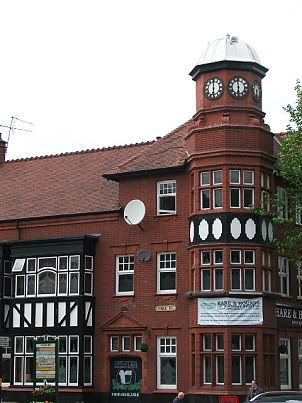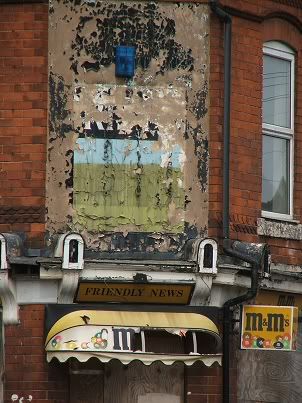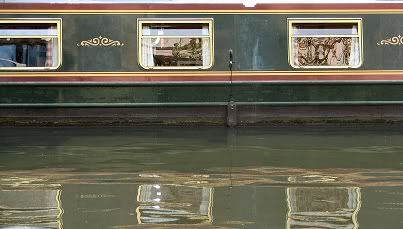
Close-up of York Street windows of the Hare & Hounds, Kings Heath
30 June 2008
29 June 2008
28 June 2008
Up and running again!
The computer is up and running!
I will do my best to catch up with the many days of missed posts but it won't be easy!
Thanks for your patience and sorry for the inconvenience :)
Hare & Hounds, Kings Heath II

Another view of the Hare & Hounds.
According to a review submitted to Google Maps, UB40 played their first gig at this pub in 1979.
27 June 2008
Hare & Hounds, Kings Heath

The Hare & Hounds in Kings Heath is a Grade II listed building situated on the corner of the High Street and York Road.
It was built in 1907 to replace the previous pub, the building of which was completed between 1820 and 1824. Originally the corner of the building was separate and used as Kings Heath's first police station by Wocestershire Rural Police in the 1840s and 1850s.
26 June 2008
25 June 2008
24 June 2008
HSBC, Kings Heath High Street

Entrance to Kings Heath High Street's HSBC bank.
HSBC was formerly Midland Bank.
23 June 2008
Vicarage Road and Kings Heath High Street: a comparison

The corner of Kings Heath High Street and Vicarage Road in 1932.

How it looks today.

The lamppost in detail.
Source for 1932 picture: The History of Kings Heath
22 June 2008
All Saints Church, Kings Heath

Hidden behind some of the few trees on the corner of Kings Heath's High Street and Vicarage Road is All Saints Church, for which I have no information.
21 June 2008
20 June 2008
Church of St Martin in the Bull Ring

Situated next to the Bullring shopping centre and competing for attention is the church of St Martin in the Bull Ring.
The present church is Victorian, but there had been church there previously since at least the thirteenth century but possibly since the twelfth.
The windows of the Victorian church were all of stained glass but not much of the original windows remain due to bomb damage sustained on 10th April 1941. None of the windows survived apart from one which had been removed and stored in boxes earlier that day, by order of Dr. W.E. Barnes, the Bishop of Birmingham at the time. It is now reinstalled in the building and can be seen with the rest of the church's interior from 10-5 every day of the week.
St Martin in the Bull Ring is a Grade II* listed building.
19 June 2008
Visitors enter the Birmingham Museum and Art Gallery

Two visitors to the Birmingham Museum and Art Gallery enter through the large doors from Chamberlain Square on a sunny day.
18 June 2008
Eastern LGV & PCV Training lorry

Vehicle make, model and registration number unknown.
Pictured outside Kings Heath and Moseley Baptist Church, Alcester Road, Kings Heath. The company is based in Tyseley, Birmingham.
15 June 2008
Candies sweet shop, Birmingham back to backs

Hurst Street's back to backs comprise the last surviving court of its kind in Birmingham. Purchased by the National Trust in 2004, they have been carefully restored and reflect the many different people who lived there since they were bulit. The houses are furnished in the styles of four different periods, from 1840 to 1977.
The first back to backs were built in 1802. Each had three rooms, one above another, and were built around a central courtyard. There were around ten people to a house. They were crammed together, hence the name, and disease was rife, but despite that thousands were built in the nineteenth century.
They were declared unfit for habitation in 1966 but in 1988, it was realised that they were an important part of history and became listed buildings.
Some of the houses are open as a museum, while 52 Inge Street is open as a Victorian styled holiday cottage, with prices starting at £132 for two nights.
Pictured here is Candies, a 1950s sweet shop open to the public selling Sela sweets. 52 Inge Street is to the right and the entrance to the rest of the court is a few doors down to the left.
14 June 2008
Three glass cube fountains, St. Martin's Square

There are a bit of a mystery to me, as I can't find much information about them anywhere. All I can find is this piece of information from cabe.org.uk:
The glass boxes used in the water feature in St. Martin’s Square [...] employed innovative techniques. The walls, structural supports and roof are all constructed from glass, requiring close collaboration with structural engineers, Dewhurst MacFarlane and Partners, and, as part of the design development, the construction of a full size mock up of the smallest cube.
Full article: http://www.cabe.org.uk/default.aspx?contentitemid=1114&aspectid=6
Each cube is a made of glass and contains a coloured light box which is illuminated at night. Water pours out the tops of the cube and runs down the sides. They are located in St. Martin's Square, outside Borders, Bullring.
13 June 2008
12 June 2008
South American/American Indian performers II

Another view of the performance outside Marks & Spencer.
11 June 2008
Lady on bike, Victoria Square

A lady cycles past the Town Hall, Victoria square on a folding bike. Surprisingly, cycling is allowed in some of the pedestrian precincts which is different from most of the rest of cyclist-unfriendly Birmingham.
10 June 2008
09 June 2008
08 June 2008
Gas Street Basin and the James Brindley

A view of Gas Street Basin showing some canal barges, with the James Brindley pub in the background.
James Brindley was an eighteenth century engineer who specialised in canals.
I have seen another photo of this pub with an M&B sign underneath the name, but I don't know what happened to that.
Apologies
Awaiting arrival of new computer. Please accept my apologies for sporadic and delayed posting.
07 June 2008
Gas Street Basin footbridge

This bridge is not as old as it looks - it was made recently in the style of the other Birmingham canal footbridges which were made by Horseley Ironworks.
The bridge links Gas Street with the Worcester Bar which separates the Worcester and Birmingham Canal from the Birmingham Canal Main Line. It was built in 1792 to prevent water being lost to the Worcester and Birmingham Canal. It reamined there for several years, during which time cargo had to be transferred across the bar to another boat. The bar was replaced with a lock in 1815 to allow boats through.
The basin used to link the 'Worcester & Birmingham Canal' to the 'Birmingham Canal Main Line'. The Worcester Bar, built in 1792, separated the two canals for 30 years so that the Birmingham Canal Navigations company didn't lose water to the Worcester & Birmingham canal.
06 June 2008
Hard a-starboard

Pictured is a canal barge on the Worcester and Birmingham canal, in Gas Street Basin, Birmingham city centre.
The Worcester and Birmingham Canal links, as its name suggests, Worcester and Birmingham. It starts at the River Severn in Worcester and ends in Gas Street Basin in Birmingham. It is 29 miles (47km) long.
The canal slopes upwards towards Birmingham and requires fifty-eight locks altogether, including the thirty Tardebigge Locks - one of the largest lock flights in Europe.
The construction of the canal was finished in 1815.
05 June 2008
Kings Heath and Moseley Baptist Church

There had been a church on this site before this one, but the building of the present Kings Heath and Moseley Baptist Church began in September 1897. It cost £7000 to build and it was planned that a spire would be added when more money became available, but it appears this was never the case. The church, built to accommodate 500 people, was opened in May 1898.
04 June 2008
'Modern grocer'

Opposite Friendly News - on the other side of Goldsmith Road, but on the same side of Addison Road - is this old grocer's shop, only identifiable by the peeling remains of the paint above the door.
03 June 2008
Friendly News

As the Salvation Army marches off to another part of Birmingham, we'll move on too, this time to Kings Heath.
This old, boarded-up shop is at 91 Addison Road B14 7EP. I don't know how long it's been closed for, but the upstairs flat isn't boarded up so it's possible that part of it is still in use, although from what one can see from the ground, even this looks fairly empty.
I almost posted a photo showing more of the shop to show what a dump Birmingham is, as it included no fewer than nine bags full of rubbish dumped by the bin outside, but I decided to concentrate on the shop itself.
02 June 2008
Salvation Army: onward march

Marching along High Street for evening prayers at 24 St. Chad's Queensway.
01 June 2008
Salvation Army: singing in High Street/New Street

The Salvation Army is of course not unique to Birmingham by any means, but I feel obliged to give a brief outline of their history nevertheless.
The Salvation Army was founded by a Nottingham-born man called William Booth. When he was thirteen years old, he started working in a pawnbroker's shop as an apprentice to help support his family and as he did so, he became more aware of the terrible poverty around him. This would affect his later life. Soon he became a Christian and spent what spare time he had trying to convert others.
He moved to London once he had completed his apprenticeship and continued to work as a pawnbroker. While there, he joined a local Methodist Church and later decided to become a minister, in which role he spent several years travelling around the country, preaching and sharing God's word. He didn't feel this was enough, however and so resigned and returned to London, determined to do more to help ordinary people.
One day, aged around thirty-six, when he was preaching in the street outside the Blind Beggar pub in the East End, some missioners were impressed by hs powerful speeches and invited him to lead some of their meetings in a tent in Whitechapel.
In July that year, the first meeting took place, and Booth gave hope to some the poverty-stricken East Enders with his speeches. Following these meetings, he formed his own organisation and called it 'The Christian Mission'.
With a lot of time and hard work, the mission began to grow but it still seemed insignificant amongst the other hundreds of charitable and religious groups trying to help in the East End.
In 1878, The Christian Mission changed its name to The Salvation Army and people suddenly took more notice. The concepts of an army fighting sin and of belonging to something special and powerful appealed immensely and many people joined up in attempt to do something good with their lives. In fact, The Salvation Army grew to be so popular that it spread abroad and by 1912 The Salvation Army had extended to fifty-eight countries.
Today, The Salvation Army's work continues and according to their own website, they provide a range of programmes and support:
3,000,000 meals served every year at community and residential centres
79,000 prisoners visited each year in 134 prisons
3,000 homeless people given food and shelter every night in 59 centres
776 local church and community centres
636 elderly people accommodated every night in 17 residential centres
300 youth clubs providing a caring environment for young people
120 drop-in centres offering support and help for people in need
70 day centres for elderly and disabled people
50 nurseries and playgroups
20 Red Shield support centres for military personnel in the UK, Germany and the Falkland Islands
12 people reunited every working day with their families through the Family Tracing Service
6 residential centres for victims of alcohol and drug abuse
6 centres for families and one community home for children
2 centres for people with special needs
2 employment training centres
1 centre for women escaping from domestic violence
In the photograph, the Birmingham Citadel Band is singing in the middle of the large junction of High Street and New Street.











